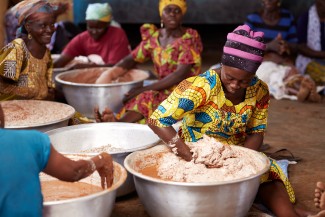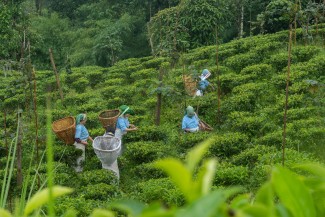Zouha Mohammed is studying the intricate skill of stitching leather, which can take months to learn. But with that expertise at hand, she now has the opportunity to generate income from her creations, items like purses, bags and keychains.
Mohammed took a course in the craft in Niamey, Niger, and can make as much as 35,000 cfa (US$58) if she sells one of her bags. She said she hopes this extra cash can translate into greater financial independence.
“Many women are active in the leather and hide processing sector in Niger. This economic participation allows them to increase their income and provide for their families,” said Abdou Adamou of the Enhanced Integrated Framework (EIF) in Niger.
“The leather and hides sector plays an essential role in Niger's economic and social development. The country has an important capacity for processing hides in rural areas and a significant production potential for small ruminants such as goats.
"Supported by a leather trade centre in Niamey, this sector is poised to meet potential demand at the national level,” Adamou added.
Niger is rife with extensive and varied livestock herds, of both cattle, sheep and red Maradi goats that are prized for their skins, and the country has been trading in such for more than 50 years. With global demand for hides sustained or even increasing, the land-locked country’s abundance of livestock means there is a lot of potential for profit.
Having identified this potential through analysis of the country’s trade situation, the Government of Niger and the Enhanced Integrated Framework (EIF) have been working to lay the foundations for trade in hides and leather that is formalized and up to standard, and in which citizens can share in the proceeds.
Mohammed is one of those individuals, working with leather from a nearby tannery that is part of a holistic support effort at commercializing the industry across eight regions of the country.
The need for skills development and training is an issue in Niger, which has high population growth and an economic focus on its uranium reserves, oil and resulting mining opportunities, with potential in its agriculture and livestock sectors. The United Nations Development Programme’s Human Development Index ranked Niger at 189 out of 189 countries in its latest 2019 report.
Mohammed was part of a group of more than 125 women trained in leatherwork, and over 600 people involved in the livestock side were trained in the proper production of hides and skins and eco-friendly tanning techniques. In addition, tanneries and women’s organizations were provided with needed equipment like sewing machines, wheelbarrows, desks, boots and more.
Abdoul Raman works at a Niamey tannery that was part of the project’s training efforts, which include increasing processing capabilities and using correct methods for drying. The tannery he works at sells its leather from goats, sheep and oxen to local leatherworkers and for export.
Approximately 80% of the country’s total production is exported, and exports go mainly to Nigeria. In 2015, animal and animal-based products made up approximately 3% of GDP.
With demand for Niger’s leather already in place, the entire sector still requires good facilities and trained staff to ensure quality, and much of the trade remains informal. With its GDP stagnating over the last 35 years, increasing exports of something Niger already has in abundance makes sense – but there are structural obstacles to be overcome.
But progress is being made.
“The sector holds so much promise for Niger’s people. It has been impressive to see the development in the tanneries and processors, in the skills, in the standards. But there is more to do so that the women and men who work in this area see stable incomes and the government sees exports increase,” EIF Coordinator Paulin Zambelongo said.
If you would like to reuse any material published here, please let us know by sending an email to EIF Communications: eifcommunications@wto.org.


